
Audiology Research
Scope & Guideline
Transforming Insights into Audiology Practices
Introduction
Aims and Scopes
- Pediatric Audiology and Disorders:
The journal extensively covers research related to pediatric patients, including assessments and management of conditions such as auditory processing disorders, cochlear implantation, and the impact of vestibular disorders on children. - Tinnitus and Hearing Loss Management:
A significant focus is placed on innovative management strategies for tinnitus and various forms of hearing loss, including the role of hearing aids, sound therapy, and cognitive behavioral approaches. - Vestibular Disorders and Rehabilitation:
Research on vestibular disorders, including diagnostic methodologies and rehabilitation techniques, is a core area, reflecting the journal's commitment to understanding balance disorders. - Technological Advancements in Audiology:
The journal publishes studies on new technologies in audiology, such as cochlear implants, hearing aids, and diagnostic tools, emphasizing their clinical application and effectiveness. - Genetic and Environmental Factors in Hearing Disorders:
There is a focus on the genetic underpinnings of hearing loss and the impact of environmental factors, exploring the intersection of genetics, audiology, and public health. - Interdisciplinary Approaches in Audiology:
The journal promotes interdisciplinary research that integrates audiology with other fields such as psychology, neurology, and public health, fostering a holistic understanding of auditory health.
Trending and Emerging
- Integration of Cognitive and Audiological Health:
Recent studies increasingly explore the relationship between cognitive function and hearing health, particularly in aging populations, highlighting the importance of addressing cognitive decline alongside hearing loss. - Telehealth and Remote Audiology Services:
There is a growing emphasis on telehealth solutions for audiology services, especially in light of the COVID-19 pandemic, indicating a shift towards more accessible and flexible patient care. - Personalized and Profile-Based Hearing Aid Fitting:
Emerging research focuses on tailoring hearing aid fittings based on individual auditory profiles, enhancing user satisfaction and outcomes, and reflecting a trend towards personalized healthcare. - Impact of Environmental and Lifestyle Factors:
Studies examining how lifestyle, including diet and physical activity, affect auditory health are gaining popularity, suggesting a shift towards preventative and holistic approaches in audiology. - Interdisciplinary Collaboration in Treatment Approaches:
There is an increasing trend towards interdisciplinary collaboration in treating auditory and vestibular disorders, integrating insights from psychology, neurology, and rehabilitation sciences.
Declining or Waning
- Traditional Audiometric Testing Methods:
There is a noticeable decrease in papers focusing solely on traditional audiometric testing methods as newer technologies and methodologies are being developed and adopted. - General Population Studies on Hearing Loss:
Research centered on broad population studies regarding hearing loss prevalence seems to be waning, possibly due to a shift towards targeted interventions and personalized approaches. - Basic Mechanistic Studies without Clinical Relevance:
Studies that focus on basic science or mechanistic insights without clear clinical applications appear to be receiving less attention, indicating a preference for research with direct implications for patient care. - Historical Perspectives or Reviews:
Although historical reviews have their place, there seems to be a decline in the frequency of such articles, as the journal shifts towards more contemporary and forward-looking research.
Similar Journals

JOURNAL OF COMMUNICATION DISORDERS
Exploring Innovations in Linguistics and Speech Therapy.Journal of Communication Disorders (ISSN: 0021-9924; E-ISSN: 1873-7994) is a leading publication in the field of communication disorders, published by Elsevier Science Inc. With a converged publishing timeline from 1967 to 2024, this journal has established itself as a vital resource for researchers, clinicians, and educators dedicated to advancing knowledge in areas such as linguistics, language processing, speech, and hearing. It boasts an impressive reputation, ranking in the Q1 category for Linguistics and Language, and Q1 in LPN and LVN as well as Q2 in Speech and Hearing for 2023, highlighting its influence and scholarly impact within these domains. The journal is recognized for its rigorous peer-reviewed articles and its contributions to our understanding of cognitive neuroscience, experimental psychology, and communication disorders—further evidenced by its ranking in the top percentiles in various fields. Although it does not currently offer Open Access options, readers and contributors alike will appreciate the depth and breadth of research published within its pages. This journal serves an essential role in bridging the gap between research and practical application, making it a must-read for anyone involved in the study or treatment of communication disorders.
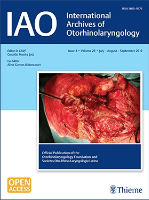
International Archives of Otorhinolaryngology
Fostering collaboration and discovery in otorhinolaryngology.The International Archives of Otorhinolaryngology is a leading peer-reviewed journal dedicated to the field of otorhinolaryngology, published by GEORG THIEME VERLAG KG. With an E-ISSN of 1809-4864, this Open Access journal has been committed to disseminating high-quality research since its inception in 2012, enabling researchers and practitioners worldwide to access the latest advancements and insights without barriers. Recognized in 2023 as a Q2 journal in the Otorhinolaryngology category, it ranks 57th out of 123 in Scopus, placing it in the 54th percentile, indicating its influence and relevance in the field. Covering a wide array of topics from clinical practices to innovative research, the journal serves as an essential resource for professionals, researchers, and students aiming to enhance their understanding and practice within this specialty. Its diverse content and dedication to promoting scientific inquiry make the International Archives of Otorhinolaryngology a cornerstone in the advancement of knowledge in ear, nose, and throat medicine.
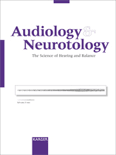
Audiology and Neurotology
Advancing the frontiers of auditory and balance science.Audiology and Neurotology, published by KARGER, stands at the forefront of research in the fields of otorhinolaryngology, audiology, and related neurosciences in Switzerland. With an impressive history of publication from 1996 to 2024, this journal caters to a diverse audience of researchers, clinicians, and students dedicated to advancing the understanding and treatment of auditory and balance disorders. Holding a significant Q1 category ranking in Otorhinolaryngology and Speech and Hearing and a commendable position in other related areas, it reflects a robust impact within its niche. Though currently operating under a subscription model, the journal remains accessible to an extensive readership striving to explore cutting-edge findings and implications for clinical practice. By disseminating high-quality research, Audiology and Neurotology continues to play a crucial role in shaping the landscape of audiological science and provides a platform for vital scholarly communication.
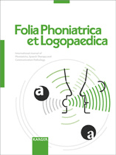
FOLIA PHONIATRICA ET LOGOPAEDICA
Advancing Communication Sciences for Tomorrow's InnovatorsFOLIA PHONIATRICA ET LOGOPAEDICA, published by KARGER in Switzerland, stands as a premier journal in the fields of linguistics, phonetics, and speech therapy. With a rich history beginning in 1949 and spanning multiple decades, this esteemed journal has maintained a commitment to advancing research and scholarship in communication sciences, covering crucial topics relevant to both clinical practice and theoretical frameworks. Holding a prestigious Q1 ranking in Linguistics and Language, the journal also achieves high standings in related categories, with notable placements in Speech and Hearing and Nursing. Researchers, professionals, and students will find the insights and findings published within its pages to be invaluable for both academic pursuits and practical applications. Access options are available through traditional subscription models, enhancing its accessibility for dedicated scholars seeking to contribute to or expand their knowledge in this dynamic field.
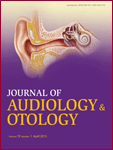
Journal of Audiology and Otology
Elevating the standards of auditory health and knowledge.The Journal of Audiology and Otology, published by the Korean Audiological Society, is a prominent peer-reviewed journal that seeks to advance the fields of audiology and otolaryngology. With its ISSN 2384-1621 and E-ISSN 2384-1710, this journal has carved out an important niche since its inception in 2016 and continues to contribute valuable research insights through to 2024. Focused on a range of topics including hearing disorders, audiological assessments, and innovations in surgical practices, the journal is categorized within the Q3 quartile in Otorhinolaryngology and has attained recognition across various related fields, achieving a Q2 ranking in Speech and Hearing. As an essential platform for professionals, researchers, and students devoted to the study of auditory and sensory systems, the Journal of Audiology and Otology is especially significant given its active engagement with the latest clinical practices and theoretical advancements in South Korea and beyond. Although it operates under a traditional access model, its rich content positioned at the intersection of clinical application and research remains critical for fostering development in the auditory sciences.
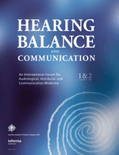
Hearing Balance and Communication
Advancing auditory and vestibular health through research.Hearing Balance and Communication is a prominent peer-reviewed journal dedicated to advancing the fields of Otorhinolaryngology, Speech, and Hearing. Published by Wolters Kluwer Medknow Publications, this journal serves as a valuable resource for researchers, clinicians, and students invested in exploring the multifaceted aspects of auditory and vestibular health. With an ISSN of 2169-5717 and an E-ISSN of 2169-5725, it has established itself as a significant platform since its inception in 2013, boasting a commendable Q3 ranking in both Otorhinolaryngology and Speech and Hearing categories as of 2023. The journal emphasizes the dissemination of original research, reviews, and case studies that foster a deeper understanding of hearing and balance, as well as effective communication practices. Located in the United Kingdom, Hearing Balance and Communication is a key player in bridging research and clinical practice, ensuring that vital findings reach the professionals who can implement them in real-world settings, thus increasingly impacting patient care and public health.

Current Otorhinolaryngology Reports
Connecting research and practice for enhanced healthcare.Current Otorhinolaryngology Reports is a vital resource for clinicians, researchers, and academics within the fields of otorhinolaryngology, immunology, neurological disorders, and surgical practices. Published by SpringerNature in Germany, this journal aims to disseminate innovative research findings, review articles, and clinical insights from 2013 to 2024, contributing significantly to advances in these dynamic specialties. With an impressive Scopus Ranking that places it within the top quartiles in several related categories, including Q3 in Otorhinolaryngology and Surgery, it provides a platform for impactful scholarship with an open-access option that enhances visibility and accessibility. Despite its current Q4 designations in other fields, the journal demonstrates a growing influence and commitment to addressing the urgent challenges faced by healthcare professionals and stakeholders in these disciplines. By engaging with the latest research published in this journal, readers can enhance their knowledge and practice, fostering collaboration and innovation in patient care.
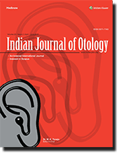
Indian Journal of Otology
Connecting Scholars in the World of Otology.Indian Journal of Otology, published by Wolters Kluwer Medknow Publications, is a prominent peer-reviewed journal dedicated to advancing the field of otology. Established in 1999, this journal serves as an essential platform for disseminating innovative research, reviews, and clinical practice advancements related to ear disorders and hearing sciences. With a current impact factor placing it in the Q3 quartile of *Otorhinolaryngology*, it reflects a robust commitment to quality and relevance in clinical practice. The journal's scope encompasses a wide range of topics, from surgical techniques to emerging therapies, making it indispensable for researchers, practitioners, and students in the audiology and otology communities. The Indian Journal of Otology is headquartered in Mumbai, India, and plays a crucial role in promoting scholarly communication within the region and beyond. Although it does not currently operate as an open-access journal, its rigorous academic standards ensure that each publication contributes meaningfully to the global understanding of ear health and related disorders.
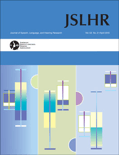
JOURNAL OF SPEECH LANGUAGE AND HEARING RESEARCH
Advancing the frontiers of communication science.JOURNAL OF SPEECH LANGUAGE AND HEARING RESEARCH, published by the American Speech-Language-Hearing Association, is a premier peer-reviewed journal dedicated to advancing the fields of speech, language, and hearing sciences. With an impressive impact factor and a strong ranking within the Q1 category of Linguistics and Language and Speech and Hearing, this journal serves as a vital resource for academics and professionals seeking to disseminate groundbreaking research and innovative practices in communication disorders. The journal, which spans actively from 1996 to 2024, offers Open Access options, facilitating broader distribution of knowledge within the scientific community. As evident from its esteemed rankings—such as #11/66 in Health Professions: Speech and Hearing—this journal not only drives forward the knowledge frontiers but also plays a crucial role in shaping policy and practice in health services. Researchers, clinicians, and students alike will find invaluable insights and empirically supported advancements within its pages, making it an essential publication in the landscape of communication and health research.
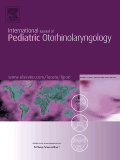
INTERNATIONAL JOURNAL OF PEDIATRIC OTORHINOLARYNGOLOGY
Fostering excellence in the diagnosis and treatment of pediatric conditions.INTERNATIONAL JOURNAL OF PEDIATRIC OTORHINOLARYNGOLOGY, published by Elsevier Ireland Ltd, stands as a pivotal resource in the fields of pediatric otorhinolaryngology, pediatrics, and related medical disciplines. With a historical publication record spanning from 1979 to 2024, this journal is dedicated to advancing research and clinical practice in the diagnosis and treatment of ear, nose, and throat disorders in children. As evidenced by its 2023 rankings, the journal maintains a commendable position within the Q2 category of its field, reflecting its impact and the quality of research it disseminates, ranking #43 out of 123 in Otorhinolaryngology and #131 out of 330 in Pediatrics. Researchers, clinicians, and students alike can benefit from a wealth of studies and reviews designed to inform and enhance pediatric care. Although the journal does not currently offer open access, it remains an indispensable tool for those seeking to stay at the forefront of pediatric health and otolaryngological innovations.